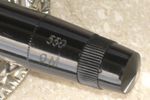Differenze tra le versioni di "Fondello/en"
(Creata pagina con "thumb|150px|a [[Colleg case back]] Although it is not as widespread and common as the other elements dealt with so far, many models have, usually...") |
(Creata pagina con "In many cases, a case back is only present for aesthetic and decorative reasons and may in turn contain specific decorations or inscriptions, such as the model number, but it...") |
||
| Riga 2: | Riga 2: | ||
Although it is not as widespread and common as the other elements dealt with so far, many models have, usually associated with their loading mechanism, a case back that covers the rear part (understood in relation to the nib) of the body of the pen. This element is not always present, as for many pens the back end is simply part of the shaft of the pen. | Although it is not as widespread and common as the other elements dealt with so far, many models have, usually associated with their loading mechanism, a case back that covers the rear part (understood in relation to the nib) of the body of the pen. This element is not always present, as for many pens the back end is simply part of the shaft of the pen. | ||
| − | In | + | In many cases, a case back is only present for aesthetic and decorative reasons and may in turn contain specific decorations or inscriptions, such as the model number, but it is fixed. In other cases it is used to cover the access to the filling system (it is common in [[button filler]]s) and can be detached, usually by unscrewing it to access the mechanism. Finally, the case back can be a direct part of the filling system itself (for filler such as the [[piston filler]] or the [[plunger filler]]) in which it generally plays the role of the part of the mechanical device on which to act to activate the loading. |
<noinclude> | <noinclude> | ||
| − | + | [[Category:Translated Pages]] | |
</noinclude> | </noinclude> | ||
Versione delle 23:33, 16 dic 2018

Although it is not as widespread and common as the other elements dealt with so far, many models have, usually associated with their loading mechanism, a case back that covers the rear part (understood in relation to the nib) of the body of the pen. This element is not always present, as for many pens the back end is simply part of the shaft of the pen.
In many cases, a case back is only present for aesthetic and decorative reasons and may in turn contain specific decorations or inscriptions, such as the model number, but it is fixed. In other cases it is used to cover the access to the filling system (it is common in button fillers) and can be detached, usually by unscrewing it to access the mechanism. Finally, the case back can be a direct part of the filling system itself (for filler such as the piston filler or the plunger filler) in which it generally plays the role of the part of the mechanical device on which to act to activate the loading.